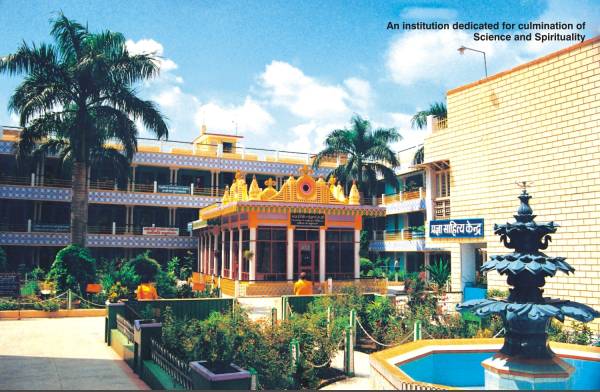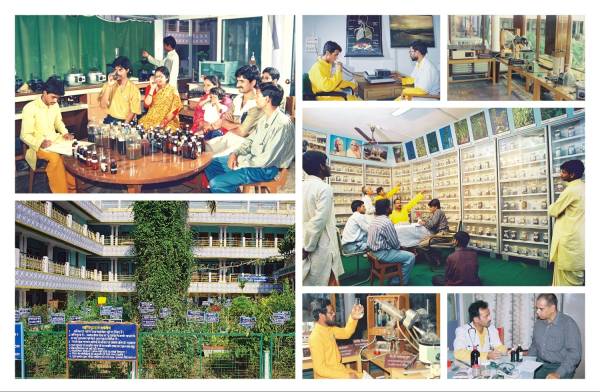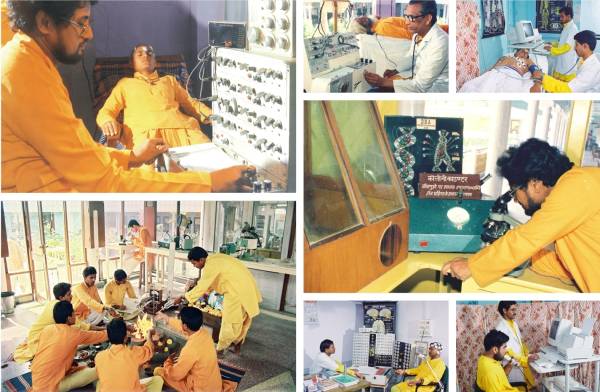Brahmvarchas Shodh Sansthan

Establishment
Dedication and Work Area
Features
Why Unique ?
Researches
Research on Effects of Gayatri Sadhana
About three thousands five hundred observations on different Clinical features, Lung-functions and Biochemical, Haemetological, Electrophysiological, Neurological and Psychometric parameters of the trainees of the one month sadhana course programmes were selected randomly (from the database of the experiments conducted since 1992) for the statistical analysis.
Observations on 22 features were collected before and after the sadhana course (anushthan) in the laboratories of the Brahms Varchas Shodh Sansthan. These were subdivided into 10 different data sets with respect to Sex and Age Group. Optimal statistical designs were constructed for the random samples drawn from each group.


Overall Results
Thorough Bio-Statistical Analysis carried out by visiting experts from IIT Bombay showed (with confidence levels 90 % to 99.9%) most significant positive effects of sadhana upon – (i) the Electrophysiological and Neurological functions – namely, GSR score and a-EEG; and (ii) Psychometric functions – especially rise in memory, decrease in illusion and reduction in the audio-visual response times. Among the haemetological parameters, a rise in Haemoglobin level was also observed with high probabilities. These effects were most prominent in the different experimental groups of women in the age groups 16 to 55 years and men in the age group 16 to 25 years. Among the Lung functions, Vital Capacity, FEV1 and MVV showed significant increase after the sadhana.
Alpha EEG (Intg. Intl. Scaled on Resistance (Microvolts)
GSR (Galvanic Skin Restistance) Score per 100 Secs.
Maximum Changes (‘Post’ – ‘Pre’) Recorded in Electrophysiological Parameters
The points 1 to 6 on the X-axis represent the respective groups, M16-25 (Males in age-group 16-25 years), M26-25, M36-45, F16-25, F26-35 and F36-45
Changes in Audio Response Time (ART) in seconds
Changes in Visual Response Time (VRT) in seconds
Memory (per ten words)
Standard Mistakes (per 100 sec.)
Maximum Changes (‘Post’ – ‘Pre’) Recorded in Psychometric Parameters
The points 1 to 6 on the X-axis represent the respective groups, M16-25 (Males in age-group 16-25 years), M26-25, M36-45, F16-25, F26-35 and F36-45
Comparison with Control Groups
About 150 men and women of in the in the age-group 16 to 45 years and having different educational background, marital status, occupation, etc were selected (as in the case of experimental studies) at random from the resident trainees at Shantikunj, Hardwar (the parent organization of BSS). These people followed the same routine as the experimental groups studied earlier, except that they were not allowed to practise any Gayatri-Sadhana. As in case of the experimental groups, observations on different Clinical Features, Pulmonary Functions and Biochemical, Haemetological, Electrophysiological, Neurological and Psychometric parameters of these subjects were collected in the BSS laboratories successively on the first day (called ‘PRE’ data) and after two to three weeks’ participation (called ‘POST’ data) in the training.
High/low BP Groups among the Experimental and Control data: Separate tests and statistical analysis were carried out on the people suffering from high/low blood pressure. The Control Groups did not show statistically significant change in any of the clinical/physiological parameters. In case of High-BP and Low-BP cases the results showed worsened effects. Whereas good results were observed in the experimental groups.
Diastolic (mm of hg)
Systolic (mm of hg)
Maximum Changes (‘Post’ – ‘Pre’) Recorded in Blood Pressure
The points 1 to 6 on the X-axis represent the respective groups, M16-25 (Males in age-group 16-25 years), M26-25, M36-45, F16-25, F26-35 and F36-45
No significant changes were found in any other parameter for the control groups except for the pulmonary function index PEFR in males and females of age group 16-25 years. In case of a-EEG, and audio-visual response times the control groups even showed negative trends.
In summary, the results for the control groups were, either negative, neutral or poorer in positive effects as compared to the experimental groups.
FEV1 (% PRED)
MVV (% PRED)
PEFR (% PRED)
FVC (% PRED)
Maximum Changes (‘Post’ – ‘Pre’) Recorded in Pulmonary (Lung) Functions
The points 1 to 6 on the X-axis represent the respective groups, M16-25 (Males in age-group 16-25 years), M26-25, M36-45, F16-25, F26-35 and F36-45
These findings confirm, with high confidence, a significant improvement in the bodily and mental functions after Gayatri Sadhana. Research in this regard would also be important in view of the alarming need for naturally effective, eco-friendly and low-cost therapies against the rising psychosomatic disorders and diseases.
Yagyopathy Research
The yagnopathy laboratory has a havan kunda places in a glass chamber and a gas analysis wing for the collection and analysis of the fumes and vapours of yagna. The efficacy of the various herbal ingredients in the havishya and the quality of the samidhas are assessed in the phytochemistry lab which is equipped with units like the gas-liquid chromatograph. The purpose is to analyse the raw content in the beginning and what is left after these substances have been fumigated.
Blood samples are kept in the glass chamber when it is full of fumes and vapours during the daily yagna (havan) and the changes in the blood biochemistry and heamotological parameters are recorded for these samples. A large number of experiments are carried out on healthy and diseased persons, living on the campus for prescribed periods. The subjects include the sadhakas as well as the non sadhakas of all age groups, men and women from all walks of life disregard of their social or religious background. During such experiments the subjects are asked to sit in the glass chamber and inhale the fumes of Yagna for specific periods of time. A thorough analysis of their body and mind is made before and after performing this experiment.
The measurements (carried out by chromatographs, multi channel physiographs, etc) of the above experiments include:
Haematological parameters like Hb, TRBC, TWBC, platelets, RBC fragility, etc
Biochemical changes like thos ein the levels of blodd urea, sugar, cholestrol, cretinine, SGOT, SGOT, etc
Immunological changes like the antibody levels and innate immunity towards various pathogenic offending organisms.
The levels of hormones like cortisol, thyroxine, ACTH, androgens, etc are recorded in the endocrinology lab. The EEG, EMG and ECG recordings are carried out in the neuro-physiology labs. The psychometry lab assesses the aptitude, learning potential, memory, the intelligence quotient, emotional quotient and the overall personality makeup of the subjects. The cases are followed on regular intervals (e.g. after performing yagna regularly for a week, or a month, etc.)
The technical details and results of this experimental research will be published subsequently in the relevant scientific journals to give directions for therapeutic use of different herbal medicines by means of yagna and further research on herbal medicine and to establish progressive ground for other scientific applications of yagna.
The general implications of the results obtained so far is that performing yagna significantly enhances the vitality and resistance against adverse metero-biological changes and against the invasion of otherwise lethal viruses and bacteria. Mental peace, emotional stability and creative development of the mind are the general observations of the analysis on the psychological fronts.
Experiments on Psychomatic Disorders
One month Gayatri Yagna (with specific herbal preparations) experiments were carried out at the centre upon about 30 to 40 males and about the same numbers of females suffering from Anxiety/Depression/Guilt/Insomnia. The control groups consisted of about ten subjects in each category.
The statistical analysis of the results (on psychological tests for measure of the extent of above diseases/disorders) showed significant improvement in the experimental group. Some Ph.D. projects (in the Dev Sanskriti University of Shantikunj, Haridwar ) are currently ongoing for further studies in this regard.
Experiments on Environmental Purification and on Tuberculosis
Two Ph. D. projects have been completed in Dev Sanskrati VishwaVidyalya (DSVV). These are entitled
“Air Quality Modelling and Non-conventional Solutions through Vedic Science for Environment Problem”
“Some Investigations into the Chemical and Pharmaceutical Aspects of Yagyopathy – Studies in Pulmonary Tuberculosis”.
Experimental work of both the projects is being carried out at the Brahmvarchas Shodh Sansthan, Haridwar . Experts (member-secretary) from the central pollution control board and Professors from the Bioscience and Bioengineering Department of Indian Institute of Technology Bombay, are associated with these research projects as external co-guides.
